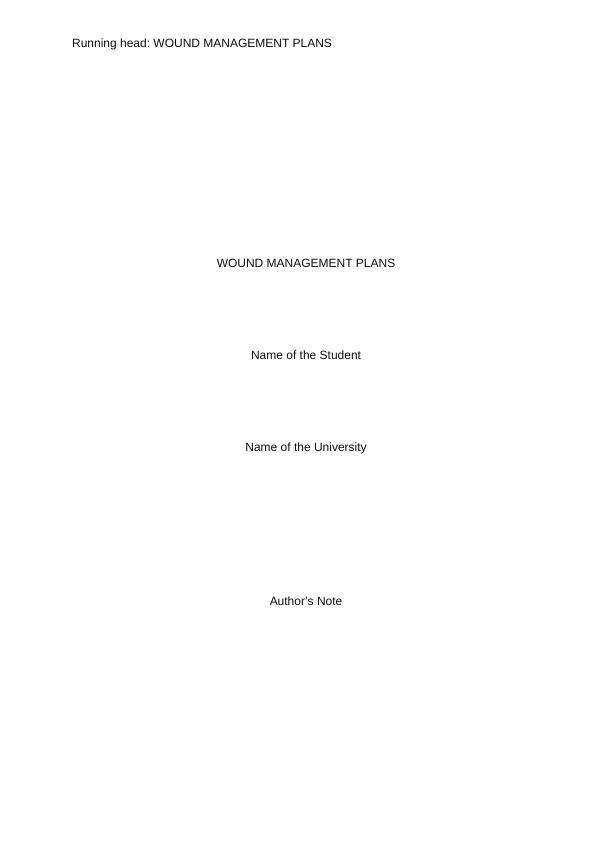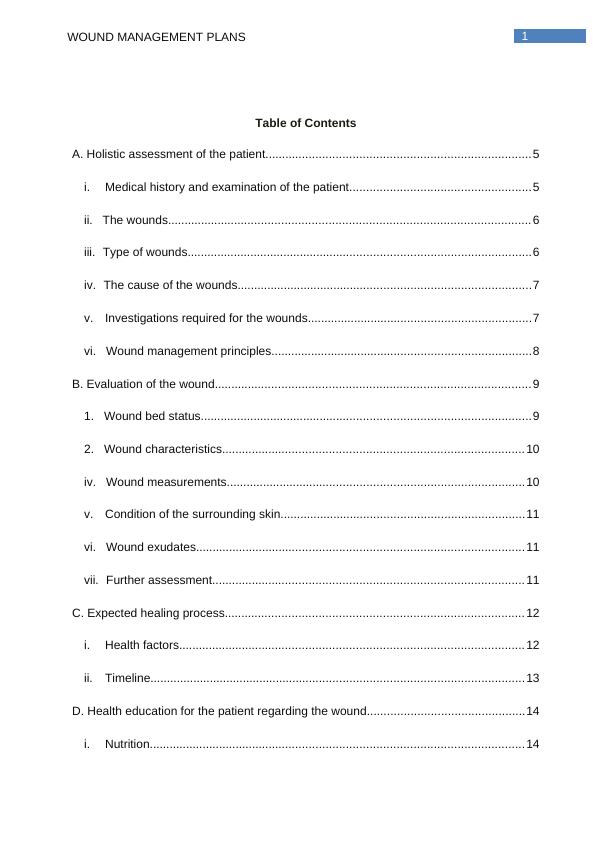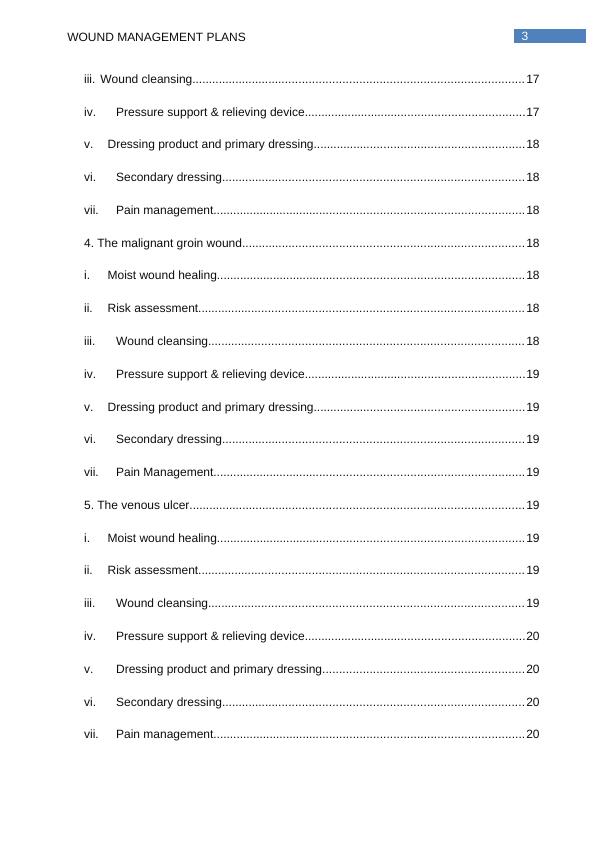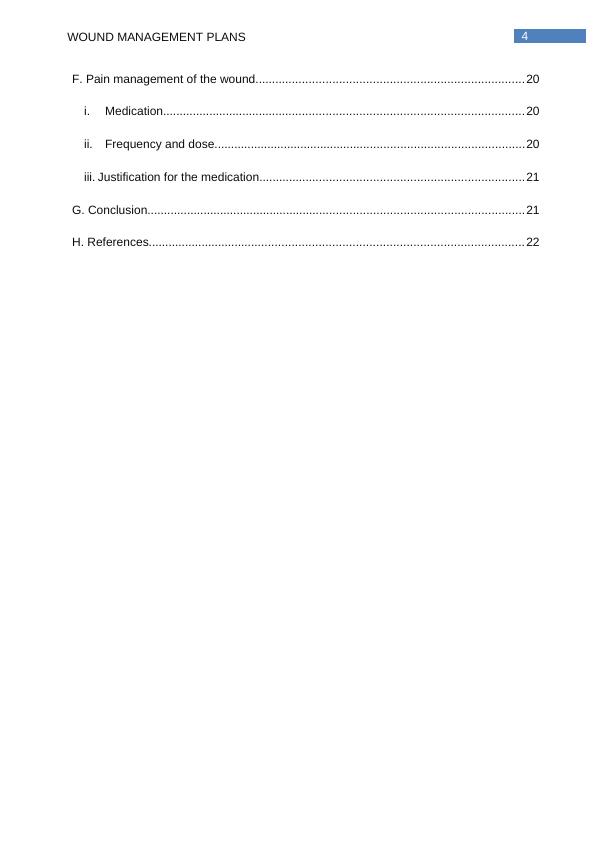Wound Management Plans for Different Types of Wounds
Added on 2023-06-08
23 Pages6159 Words132 Views
Running head: WOUND MANAGEMENT PLANS
WOUND MANAGEMENT PLANS
Name of the Student
Name of the University
Author’s Note
WOUND MANAGEMENT PLANS
Name of the Student
Name of the University
Author’s Note

1WOUND MANAGEMENT PLANS
Table of Contents
A. Holistic assessment of the patient...............................................................................5
i. Medical history and examination of the patient......................................................5
ii. The wounds............................................................................................................ 6
iii. Type of wounds.......................................................................................................6
iv. The cause of the wounds........................................................................................7
v. Investigations required for the wounds...................................................................7
vi. Wound management principles..............................................................................8
B. Evaluation of the wound.............................................................................................. 9
1. Wound bed status...................................................................................................9
2. Wound characteristics..........................................................................................10
iv. Wound measurements.........................................................................................10
v. Condition of the surrounding skin.........................................................................11
vi. Wound exudates..................................................................................................11
vii. Further assessment.............................................................................................11
C. Expected healing process......................................................................................... 12
i. Health factors....................................................................................................... 12
ii. Timeline................................................................................................................13
D. Health education for the patient regarding the wound...............................................14
i. Nutrition................................................................................................................14
Table of Contents
A. Holistic assessment of the patient...............................................................................5
i. Medical history and examination of the patient......................................................5
ii. The wounds............................................................................................................ 6
iii. Type of wounds.......................................................................................................6
iv. The cause of the wounds........................................................................................7
v. Investigations required for the wounds...................................................................7
vi. Wound management principles..............................................................................8
B. Evaluation of the wound.............................................................................................. 9
1. Wound bed status...................................................................................................9
2. Wound characteristics..........................................................................................10
iv. Wound measurements.........................................................................................10
v. Condition of the surrounding skin.........................................................................11
vi. Wound exudates..................................................................................................11
vii. Further assessment.............................................................................................11
C. Expected healing process......................................................................................... 12
i. Health factors....................................................................................................... 12
ii. Timeline................................................................................................................13
D. Health education for the patient regarding the wound...............................................14
i. Nutrition................................................................................................................14

2WOUND MANAGEMENT PLANS
ii. Mobility................................................................................................................. 14
iii. Preventative measures.....................................................................................14
E. Wound management plan..........................................................................................15
1. The diabetic foot ulcer............................................................................................15
i. Moist wound healing............................................................................................. 15
ii. Risk assessment.................................................................................................... 15
iii. Wound cleansing...................................................................................................15
iv. Pressure support & relieving device......................................................................15
v. Dressing product and primary dressing...............................................................15
vi. Secondary dressing...............................................................................................16
2. The arterial ulcer.....................................................................................................16
i. Moist wound healing............................................................................................16
ii. Risk assessment................................................................................................. 16
iii. Wound cleansing...................................................................................................16
iv. Pressure support & relieving device......................................................................16
v. Dressing product and primary dressing...............................................................17
vi. Secondary dressing...............................................................................................17
vii. Pain management.............................................................................................17
3. The stage 3 pressure ulcer.....................................................................................17
i. Moist wound healing............................................................................................17
ii. Risk assessment................................................................................................. 17
ii. Mobility................................................................................................................. 14
iii. Preventative measures.....................................................................................14
E. Wound management plan..........................................................................................15
1. The diabetic foot ulcer............................................................................................15
i. Moist wound healing............................................................................................. 15
ii. Risk assessment.................................................................................................... 15
iii. Wound cleansing...................................................................................................15
iv. Pressure support & relieving device......................................................................15
v. Dressing product and primary dressing...............................................................15
vi. Secondary dressing...............................................................................................16
2. The arterial ulcer.....................................................................................................16
i. Moist wound healing............................................................................................16
ii. Risk assessment................................................................................................. 16
iii. Wound cleansing...................................................................................................16
iv. Pressure support & relieving device......................................................................16
v. Dressing product and primary dressing...............................................................17
vi. Secondary dressing...............................................................................................17
vii. Pain management.............................................................................................17
3. The stage 3 pressure ulcer.....................................................................................17
i. Moist wound healing............................................................................................17
ii. Risk assessment................................................................................................. 17

3WOUND MANAGEMENT PLANS
iii. Wound cleansing...................................................................................................17
iv. Pressure support & relieving device..................................................................17
v. Dressing product and primary dressing...............................................................18
vi. Secondary dressing..........................................................................................18
vii. Pain management.............................................................................................18
4. The malignant groin wound....................................................................................18
i. Moist wound healing............................................................................................18
ii. Risk assessment................................................................................................. 18
iii. Wound cleansing.............................................................................................. 18
iv. Pressure support & relieving device..................................................................19
v. Dressing product and primary dressing...............................................................19
vi. Secondary dressing..........................................................................................19
vii. Pain Management.............................................................................................19
5. The venous ulcer....................................................................................................19
i. Moist wound healing............................................................................................19
ii. Risk assessment................................................................................................. 19
iii. Wound cleansing.............................................................................................. 19
iv. Pressure support & relieving device..................................................................20
v. Dressing product and primary dressing............................................................20
vi. Secondary dressing..........................................................................................20
vii. Pain management.............................................................................................20
iii. Wound cleansing...................................................................................................17
iv. Pressure support & relieving device..................................................................17
v. Dressing product and primary dressing...............................................................18
vi. Secondary dressing..........................................................................................18
vii. Pain management.............................................................................................18
4. The malignant groin wound....................................................................................18
i. Moist wound healing............................................................................................18
ii. Risk assessment................................................................................................. 18
iii. Wound cleansing.............................................................................................. 18
iv. Pressure support & relieving device..................................................................19
v. Dressing product and primary dressing...............................................................19
vi. Secondary dressing..........................................................................................19
vii. Pain Management.............................................................................................19
5. The venous ulcer....................................................................................................19
i. Moist wound healing............................................................................................19
ii. Risk assessment................................................................................................. 19
iii. Wound cleansing.............................................................................................. 19
iv. Pressure support & relieving device..................................................................20
v. Dressing product and primary dressing............................................................20
vi. Secondary dressing..........................................................................................20
vii. Pain management.............................................................................................20

4WOUND MANAGEMENT PLANS
F. Pain management of the wound................................................................................20
i. Medication............................................................................................................20
ii. Frequency and dose.............................................................................................20
iii. Justification for the medication...............................................................................21
G. Conclusion.................................................................................................................21
H. References................................................................................................................ 22
F. Pain management of the wound................................................................................20
i. Medication............................................................................................................20
ii. Frequency and dose.............................................................................................20
iii. Justification for the medication...............................................................................21
G. Conclusion.................................................................................................................21
H. References................................................................................................................ 22

5WOUND MANAGEMENT PLANS
A. Holistic assessment of the patient
i. Medical history and examination of the patient
Case Study 1:
The first case study is on Mr. Will Jackson, a 77 year old who had been
diagnosed with rectal cancer five years ago. He has a clinical history of ischemic heart
disease (IHD) which attributed to his coronary artery bypass grafting (CABG) two years
ago. He also has Chronic Obstructive Pulmonary Disease (COPD) along with Gastro-
oesophageal reflux disease (GORD) and a history of alcohol abuse. He also suffers
from postural hypotension and takes insulin to control his type 2 diabetes mellitus. He
also suffers from intermittent confusion and mild lack of cognitive integrity at times. He
lives alone in a retirement village since his wife passed away a year ago. His urine
output is incontinent and requires pad in situ. He can walk a few steps for a short
distance with help however requires wheelchair assistance for longer distances.
Mr. Jackson has been admitted with pain, shortness of breath and for
management of his wounds. Prior to his admission, he had struck his head during a fall
at home and had a substantially large bruise over his face. The CT scan of Mr.
Jackson’s head did not reveal any significant damage; however the doctor stopped his
warfarin dose for a week due to this massive bruise as warfarin was being used to
reduce blood clots thereby aiding his CABG.
Case Study 2:
The second case study is on an 85 year old Mrs. Miriam Gold who has been
admitted with fluids overload problem and has pneumonia along with metastatic cervical
cancer. Mrs. Gold has a rectovaginal fistula due to her progressed cancer and
radiotherapy. Additionally, the patient has a long standing venous ulcer that is not
healing. Mrs. Gold has a medical history of Chronic Obstructive Pulmonary Disease
(COPD) and Gastro-oesophageal reflux disease (GORD) along with presence of
coronary artery bypass graft (CABG). Her mobility is restricted to resting in bed and is
cognitively drowsy and vague. She is on a semi liquid diet, comprised of mild thick fluids
and is incontinent, requiring pad in situ.
A. Holistic assessment of the patient
i. Medical history and examination of the patient
Case Study 1:
The first case study is on Mr. Will Jackson, a 77 year old who had been
diagnosed with rectal cancer five years ago. He has a clinical history of ischemic heart
disease (IHD) which attributed to his coronary artery bypass grafting (CABG) two years
ago. He also has Chronic Obstructive Pulmonary Disease (COPD) along with Gastro-
oesophageal reflux disease (GORD) and a history of alcohol abuse. He also suffers
from postural hypotension and takes insulin to control his type 2 diabetes mellitus. He
also suffers from intermittent confusion and mild lack of cognitive integrity at times. He
lives alone in a retirement village since his wife passed away a year ago. His urine
output is incontinent and requires pad in situ. He can walk a few steps for a short
distance with help however requires wheelchair assistance for longer distances.
Mr. Jackson has been admitted with pain, shortness of breath and for
management of his wounds. Prior to his admission, he had struck his head during a fall
at home and had a substantially large bruise over his face. The CT scan of Mr.
Jackson’s head did not reveal any significant damage; however the doctor stopped his
warfarin dose for a week due to this massive bruise as warfarin was being used to
reduce blood clots thereby aiding his CABG.
Case Study 2:
The second case study is on an 85 year old Mrs. Miriam Gold who has been
admitted with fluids overload problem and has pneumonia along with metastatic cervical
cancer. Mrs. Gold has a rectovaginal fistula due to her progressed cancer and
radiotherapy. Additionally, the patient has a long standing venous ulcer that is not
healing. Mrs. Gold has a medical history of Chronic Obstructive Pulmonary Disease
(COPD) and Gastro-oesophageal reflux disease (GORD) along with presence of
coronary artery bypass graft (CABG). Her mobility is restricted to resting in bed and is
cognitively drowsy and vague. She is on a semi liquid diet, comprised of mild thick fluids
and is incontinent, requiring pad in situ.

End of preview
Want to access all the pages? Upload your documents or become a member.
Related Documents
Unit 09 : Entrepreneurship And Small Business Managementlg...
|29
|8633
|75
Global Entrepreneurshiplg...
|25
|5054
|50
BUS5PA: Building and Evaluating Predictive Models | Assignmentlg...
|25
|2918
|37
BUS5PA - Predictive Analytics Assignmentlg...
|25
|3024
|434
ITECH1000 Programming 1 Assessment 2lg...
|26
|2595
|67
International Business Strategy Assignment| Deskliblg...
|30
|7351
|232
